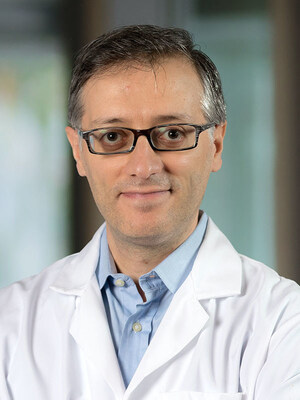BRONX, N.Y., March 28, 2022 /PRNewswire/ -- Revving up a process that slows down as we age may protect against atherosclerosis, a major cause of heart attacks and strokes. In findings publishing online this week in Proceedings of the National Academy of Sciences (PNAS), scientists at Albert Einstein College of Medicine led by Ana Maria Cuervo, M.D., Ph.D., successfully minimized artery-narrowing plaque in mice that would otherwise develop those lesions. The researchers did so by boosting chaperone-mediated autophagy (CMA), a cellular housekeeping process that Dr. Cuervo discovered in 1993 and named in 2000.
"We've shown in this research that we need CMA to protect against atherosclerosis, which becomes severe and progresses when CMA declines—something that also happens when people get older," said Dr. Cuervo, professor of developmental and molecular biology and of medicine, the Robert and Renée Belfer Chair for the Study of Neurodegenerative Diseases, and co-director of the Institute for Aging Research at Einstein. "But equally important, we've proven that increasing CMA activity can be an effective strategy for curbing atherosclerosis and halting its progression."
An Impressive CMA CV
CMA keeps cells functioning normally by selectively degrading the many proteins that cells contain. In CMA, specialized "chaperone" proteins bind to proteins in the cytoplasm and guide them to enzyme-filled cellular structures called lysosomes to be digested and recycled. Dr. Cuervo has deciphered many of the molecular players involved in CMA and shown that CMA, through its timely degradation of key proteins, regulates numerous intracellular processes including glucose and lipid metabolism, circadian rhythms and DNA repair. She also found that disrupted CMA allows damaged proteins to accumulate to toxic levels, contributing to aging and—when the toxic buildup occurs in nerve cells—to neurodegenerative diseases including Parkinson's, Alzheimer's, and Huntington's disease.
Dr. Cuervo's achievements were recognized in 2019 when she was elected to the National Academy of Sciences (NAS). In 1996, the NAS began inviting its newly elected members to submit a special Inaugural Article to PNAS that would underscore the member's scientific contributions. Due to COVID-19 pandemic-related delays, today's paper on CMA's protective role against atherosclerosis is Dr. Cuervo's inaugural PNAS paper and adds to her body of work on the importance of CMA.
Fighting Back Against Plaque
Cardiovascular disease (CVD) is the world's leading cause of death, with more than 80% of those CVD deaths due to heart attacks and strokes. CVD, in turn, is usually associated with atherosclerosis: the buildup of plaque (a sticky material consisting of fat, cholesterol, calcium, and other substances) within the walls of arteries. Accumulating plaque hardens and narrows arteries, preventing them from delivering oxygenated blood to heart muscle (leading to heart attacks), the brain (strokes), and to the rest of the body.
To investigate CMA's role in atherosclerosis, Dr. Cuervo and colleagues promoted atherosclerosis in mice by feeding them a fatty Western diet for 12 weeks and monitoring CMA activity in plaque-affected aortas of the animals. CMA activity initially increased in response to the dietary challenge; after 12 weeks, however, plaque buildup was significant, and virtually no CMA activity could be detected in the two types of cells—macrophages and arterial smooth muscle cells—that are known to malfunction in atherosclerosis, leading to the buildup of plaque within arteries.
"CMA seemed to be very important in protecting macrophages and smooth muscle cells—helping them function normally despite the pro-atherosclerotic diet—at least for a while, until their CMA activity basically came to a halt," said Dr. Cuervo. She noted that feeding the high-fat diet to mice totally lacking in CMA activity produced even stronger evidence of CMA's importance: plaques nearly 40% larger than those in control animals that were also on the high-fat diet.
Of Mice and Also Men
The researchers found evidence that weak CMA activity correlates with atherosclerosis in people too. Some patients who have had strokes undergo a surgical procedure, known as carotid endarterectomy, that removes plaque-affected segments of their carotid arteries to reduce the risk of a second stroke. Dr. Cuervo and her colleagues analyzed CMA activity in carotid artery segments from 62 first-stroke patients who were followed for three years after their surgery.
"Those patients with higher levels of CMA following their first strokes never got a second one, while second strokes occurred in nearly all the patients with low CMA activity," said Dr. Cuervo. "This suggests that your CMA activity level post-endarterectomy could help in predicting your risk for a second stroke and in guiding treatment, especially for people with low CMA."
Turning Up CMA, Tuning Out Atherosclerosis
The study is the first to show that turning up CMA could be an effective way to prevent atherosclerosis from becoming severe or progressing. The researchers genetically "upregulated" CMA in mice that were fed a pro-atherosclerotic, high-fat Western diet and later compared them with control mice fed the same diet for 12 weeks. The CMA-boosted mice had greatly improved blood lipid profiles, with markedly reduced levels of cholesterol compared with the control mice. Plaque lesions that formed in the genetically altered mice were significantly smaller and milder in severity compared with plaques in control mice. Fortunately, people won't need genetic alteration to benefit from this finding.
"My colleagues and I have developed drug compounds that have shown promise for safely and effectively increasing CMA activity in most mouse tissues and in human-derived cells," said Dr. Cuervo. Einstein has filed intellectual property on this underlying technology.
The PNAS paper is titled "Protective role of chaperone-mediated autophagy against atherosclerosis." Other Einstein authors were Julio Madrigal-Matute, Ph.D., Dario F. Riascos-Bernal, Antonio Diaz, M.D., Ph.D., Inmaculada Tasset, Ph.D., Adrian Martin-Segura, Ph.D., Susmita Kaushik, Ph.D., Simoni Tiano, M.D., Matthieu Bourdenx, Ph.D., Gregory J. Krause, M.S., Nicholas Sibinga, M.D., Fernando Macian, M.D., Ph.D., and Rajat Singh, M.D. The paper's other co-corresponding author is Judith C. Sluimer, Ph.D., of Maastricht University Medical Centre in The Netherlands and the University of Edinburgh in the United Kingdom.
About Albert Einstein College of Medicine
Albert Einstein College of Medicine is one of the nation's premier centers for research, medical education and clinical investigation. During the 2021-22 academic year, Einstein is home to 732 M.D. students, 190 Ph.D. students, 120 students in the combined M.D./Ph.D. program, and approximately 250 postdoctoral research fellows. The College of Medicine has more than 1,900 full-time faculty members located on the main campus and at its clinical affiliates. In 2021, Einstein received more than $185 million in awards from the National Institutes of Health. This includes the funding of major research centers at Einstein in cancer, aging, intellectual development disorders, diabetes, clinical and translational research, liver disease, and AIDS. Other areas where the College of Medicine is concentrating its efforts include developmental brain research, neuroscience, cardiac disease, and initiatives to reduce and eliminate ethnic and racial health disparities. Its partnership with Montefiore, the University Hospital and academic medical center for Einstein, advances clinical and translational research to accelerate the pace at which new discoveries become the treatments and therapies that benefit patients. For more information, please visit einsteinmed.org, read our blog, follow us on Twitter, like us on Facebook, and view us on YouTube.
SOURCE Albert Einstein College of Medicine
WANT YOUR COMPANY'S NEWS FEATURED ON PRNEWSWIRE.COM?
Newsrooms &
Influencers
Digital Media
Outlets
Journalists
Opted In






Share this article